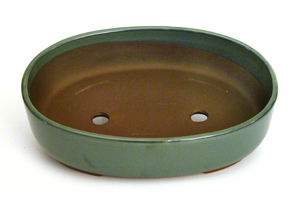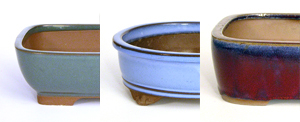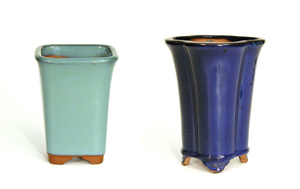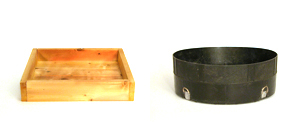A bonsai pot is not just any pot! A bonsai pot serves a function beyond merely containing the tree and the potting medium. It is an integral part of the bonsai image, and must complement the tree in much the same way as a frame complements a painting.
 Bonsai pots
Bonsai pots
Are very beautiful, an art form requiring highly skilled artists.
Are much more shallow than regular plant pots, hence the frequent reference to bonsai ‘trays.’
Are stoneware or ceramic, as opposed to the common earthenware flower pots. They have been fired to much higher temperatures, and thus are much more hardy.
Have huge drainage holes. These ‘25-cent-piece’ sized holes must have mesh screening in place over them to prevent the soil from running out the bottom of the pot.
 Have feet
Have feet
which raise the pot bottom from the bonsai bench, allowing draining water to run freely away. Their feet may be plain and straight, or curved and fancy.
May be an unglazed, rich brown in color
 Bonsai pots may be an unglazed, rich brown in color, or glazed to soft, subtle colours such as green, grey, blue, cream, or warm white. In shape they may be round, square, octagonal, oval, or oblong. Their profile may be straight-sided, lipped, flared, or incurved.
Bonsai pots may be an unglazed, rich brown in color, or glazed to soft, subtle colours such as green, grey, blue, cream, or warm white. In shape they may be round, square, octagonal, oval, or oblong. Their profile may be straight-sided, lipped, flared, or incurved.
Small as a teacup
 A bonsai pot may be as small as a teacup, or even a thimble, or as large as a baby’s bath. Traditional, established guidelines help bonsaiists select the appropriate size, shape and color to best complement each tree style and species.
A bonsai pot may be as small as a teacup, or even a thimble, or as large as a baby’s bath. Traditional, established guidelines help bonsaiists select the appropriate size, shape and color to best complement each tree style and species.

Balance the downward sweep of cascades
Pots for cascade and semi-cascade bonsai are, of necessity, much deeper, in order to balance the downward sweep of these two styles.
 Training pots must be shallow
Training pots must be shallow
Until bonsai are ready for such fine pots as described here, but after they have been collected from the wild or lifted from the garden, they can be planted into ‘training pots’. These can be as simple as seed trays or even shallow wooden boxes lined with screen, as long as they are free draining.
Training pots must be shallow, to encourage the tree roots to develop horizontally.
Beginners should beware of poorly-made pots, especially those with uneven bottoms, hollows in the feet, or carelessly made drain holes. All of these are serious flaws, as water may collect or be prevented from draining freely, causing root rot— one of the most common causes of tree mortality.
